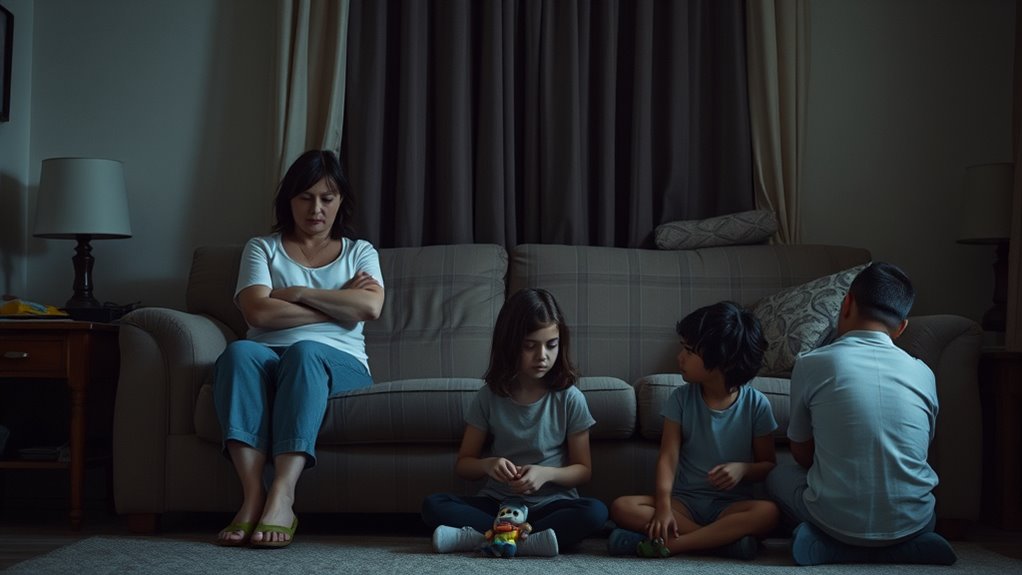The silent treatment in the family system signals emotional distance and often indicates conflict avoidance rather than temporary upset. It may stem from fears of confrontation or unresolved hurt, and over time, it erodes trust and intimacy. When you use silence as a weapon, you create more misunderstandings and disconnect. Recognizing what’s behind this behavior can help you address deeper issues. If you keep exploring, you’ll discover effective ways to reconnect and rebuild trust.
Key Takeaways
- The silent treatment signals emotional distance and often indicates underlying family conflicts or unresolved issues.
- It functions as a defense mechanism, protecting individuals from emotional discomfort and confrontation.
- Prolonged silence erodes trust, intimacy, and can deepen emotional divides within the family system.
- Recognizing silence as a symptom rather than indifference helps facilitate understanding and healing.
- Addressing the silent treatment requires patience, gentle communication, and mutual effort to rebuild connection.

Have you ever experienced a tense silence from a family member and wondered why they’re avoiding you? It’s an unsettling feeling, especially when you’re left guessing what went wrong. That silence often signals more than just a temporary mood; it reflects emotional distance that has built up over time. When someone in your family withdraws through the silent treatment, it’s usually a way of avoiding conflict rather than addressing it directly. Conflict avoidance becomes a pattern, where the person chooses silence over confrontation, hoping it will make problems go away. But instead, it deepens the emotional divide, making it harder for you to connect or understand their feelings.
Silent treatment signals emotional distance and conflict avoidance, deepening the divide over time.
This emotional distance isn’t accidental. It’s often a defense mechanism, a way for family members to protect themselves from emotional discomfort. When conflict arises, rather than facing it head-on, some people retreat into silence to avoid the stress and vulnerability that come with disagreement. They may think that silence will make the problem disappear, but it usually just prolongs the pain. You might find yourself feeling rejected, confused, or even guilty, wondering if you did something wrong. The truth is, the silent treatment isn’t about you; it’s about their struggle to manage their own emotions or fears of confrontation. Recognizing that conflict avoidance can lead to emotional distancing highlights the importance of addressing underlying issues instead of ignoring them.
Understanding why conflict avoidance leads to the silent treatment can help you respond more compassionately. Instead of taking it personally, recognize that the silence is often a symptom of deeper issues, like unresolved hurt or anxiety. Some family members fear that expressing their feelings openly will escalate the conflict or cause more pain, so they opt for silence as a way to keep the peace—at least on the surface. This approach might seem like a way to prevent chaos, but it usually causes more emotional harm in the long run. It leaves you feeling unheard and disconnected, which can erode trust and intimacy over time.
If you want to break this cycle, it’s important to approach the situation with patience. Encourage open dialogue without pressuring them, making it clear that you’re willing to listen and understand. Sometimes, giving space and showing consistent kindness can help the other person feel safe enough to lower their guard. Remember, addressing emotional distance requires effort from both sides. Recognizing that conflict avoidance is often rooted in fear, rather than stubbornness or indifference, can change how you respond. Patience, empathy, and gentle communication are key to healing the wounds caused by the silent treatment and restoring a healthier, more connected family dynamic. Being aware of emotional defense mechanisms like withdrawal can guide you toward more effective ways of fostering open communication.
Frequently Asked Questions
How Can I Gently Break the Silence Without Causing Conflict?
You can gently break the silence by starting with a calm, open gesture, like a warm smile or a simple hello. Use active listening to show genuine interest, and express your feelings honestly without blame. Encourage emotional openness by asking gentle questions, and be patient as trust builds. Remember, small, consistent efforts help create a safe space, reducing conflict and fostering understanding in your family.
What Are the Long-Term Effects of Silent Treatment on Children?
The silent treatment can negatively impact your child’s emotional development and attachment styles long-term. It may cause them to feel insecure, anxious, or develop avoidant attachment patterns. Over time, they might struggle to trust others or express their feelings openly. To foster healthy emotional growth, you should communicate openly and consistently, showing your child that they are valued and that conflicts can be resolved through conversation, not silence.
How Do Cultural Differences Influence the Silent Treatment in Families?
Think of silent treatment as a quiet river flowing differently across cultures. In some, cultural communication emphasizes harmony, making silence a gentle wave that preserves familial boundaries. In others, silence might symbolize disapproval or distance, shaping how families handle conflicts. Your cultural background influences whether silence is a shield or a signal, affecting how familial boundaries are maintained or crossed. Understanding these nuances helps you navigate family dynamics with sensitivity and insight.
Can Therapy Effectively Resolve Silent Treatment Issues Within Families?
Yes, therapy can effectively resolve silent treatment issues within families. It helps improve family communication by encouraging honest expression and understanding emotional boundaries. Through guided sessions, you learn to identify underlying causes of silence and develop healthier ways to connect. Therapy fosters a safe environment where family members can rebuild trust, address conflicts, and strengthen relationships, ultimately breaking the cycle of silent treatment and promoting lasting emotional connection.
What Are Signs That Silent Treatment Is Becoming Emotionally Abusive?
You notice the silent treatment turning cold and heavy like a brick wall, with you feeling trapped and unheard. When emotional manipulation and passive aggression become frequent, it’s a sign it’s crossing into emotional abuse. If silence is used to control, punish, or belittle, rather than to seek understanding, it’s time to recognize these signs and seek support, because healthy communication shouldn’t feel like walking on eggshells.
Conclusion
Remember, the silent treatment is like a cold shadow cast over your family’s heart. It may seem like a shield, but it’s really a wall that isolates and wounds. Break the silence with your voice and compassion, letting warmth and understanding seep through the cracks. Rebuild the bridges that distance has weakened, and watch your family’s love bloom once more. Silence may feel safe, but connection is the true foundation of a thriving family.
Our Content Strategist, Jordan, has a knack for deciphering the digital landscape to determine what our audience seeks. With a foundation in behavioral science and digital marketing, Jordan crafts our content strategy, ensuring that our topics are relevant, research-based, and resonant. Their strategic approach helps Narcissistic Man reach hearts and minds across the globe.











